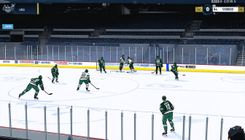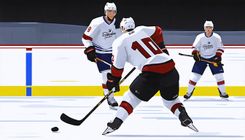NHLs New CBA Provisions Present New Development Opportunities for Prospects

The current NHL collective bargaining agreement (CBA), which is set to expire in September 2026, is a crucial topic for those involved in the sport. Recently, NHL owners and the NHL Players Association reached an agreement on a new framework for the CBA. While the full Memorandum of Understanding of the new CBA has not yet been made public, notable changes have been reported, including a significant alteration to how teams handle their prospects. According to NHL insider Frank Seravalli, starting with the new CBA, each NHL team will have the option to assign one 19-year-old prospect to their American Hockey League (AHL) team each season, impacting up to 32 players annually.
The implications of this rule are vast when examining the traditional pathways for players transitioning from junior leagues to the NHL. Under the existing CHL-NHL agreement, players drafted from Canadian major-junior leagues such as the Ontario Hockey League (OHL), Western Hockey League (WHL), or Quebec Major Junior Hockey League (QMJHL) are restricted from moving to the AHL or ECHL until they turn 20 years old or complete four seasons in the CHL. Players drafted from other junior leagues and who later join a CHL team are exempt from this limitation. The new rules set to take effect in the 2026-2027 season stand to primarily affect prospects born in 2007 and later.
For instance, Braeden Cootes, a prospect for the Vancouver Canucks, will turn 19 in February 2026. If the Canucks determine that his development might benefit from a stint in the AHL, he could be assigned to the Abbotsford Canucks that following autumn. The age-based assignment system introduces a new level of flexibility; under the upcoming regulations, a player drafted from the CHL who turns 19 shortly after being selected could potentially bypass returning to junior hockey altogether. An example of this could be Ryan Roobroeck, a highly-anticipated prospect eligible for the 2026 draft. Born in September 2007, Roobroeck could sign an entry-level contract and adapt quickly with an NHL team’s development structure, possibly resulting in an assignment directly to the AHL instead of returning to the Niagara IceDogs of the OHL.
This newly established path reflects a significant development opportunity for CHL-affiliated prospects who might not be ready for the NHL yet lack productive alternatives. Historically, there have been instances illustrating the need for such a developmental approach; one such example is Dylan Strome, who was too skilled for junior hockey after being drafted yet was not prepared for NHL duties. Strome faced developmental challenges during his tenure with the Arizona Coyotes due to limited options. If the opportunity to transition to the AHL had been available, it could have facilitated a smoother integration into the professional ranks, potentially mitigating the 'bust' label that followed him early in his career.
Furthermore, recent cases have provided insights into the effectiveness of such developmental strategies. During the pandemic, Cole Perfetti played for the Manitoba Moose after the OHL season was canceled, demonstrating the viability of AHL experience for junior players. Similarly, Shane Wright received special permission to compete with the AHL's Coachella Valley Firebirds during the 2023-2024 season due to exceptional circumstances surrounding his OHL career. Both players benefitted significantly from gaining experience at the AHL level rather than returning to junior hockey. The established rule indicating 'one player per organization per season' suggests that teams cannot repeatedly assign different 19-year-olds during a single year, but this is unlikely to pose much of an issue, as few teams have multiple eligible prospects simultaneously.
This change is advantageous for NHL teams looking to develop their top prospects closer to home, allowing for direct observation and engagement during practices and games. Conversely, the ramifications could be challenging for CHL teams, which might lose key players to the AHL development path. The understanding that only one player may be assigned could be influenced by the CHL's interests; junior teams are understandably reluctant to surrender their top talent. Although each NHL team is limited to one 19-year-old assignment yearly, there are no restrictions on the number of players drawn from each CHL team, which poses a risk for junior clubs with multiple promising prospects.
The transition opens avenues for players who may otherwise face year-long delays in their development. These prospects, particularly from junior powerhouse teams like the London Knights, could find greater value in direct exposure to professional-level competition rather than remaining in a dominant junior environment where they may not face significant challenges. Such conditions may hinder growth if players do not encounter adversity through competition. NHL teams keen on helping their top young talents might leverage this new rule to facilitate their players’ development more aggressively.
Moreover, this development pathway can potentially alter the decision-making process for many young athletes. As Scott Wheeler of The Athletic notes, several agents have indicated that their clients may prefer the CHL-to-AHL option, especially when weighing signing bonuses against collegiate opportunities. Additionally, factors such as potential arbitration rights becoming accessible earlier by playing in the AHL at 19 could present appealing incentives to players, enhancing the situation for those looking to transition to pro hockey sooner rather than later.
In conclusion, the adjustments to player assignment practices under the forthcoming NHL CBA will reshape the development landscape significantly. Phenomenal young talents no longer find themselves caught in a cycle of unsuitable options; they can now step into professional hockey at a younger age, benefiting from immediate competition while refining their skills. As the CBA approaches its implementation date, the broader implications for NHL franchises, junior teams, and aspiring professional players will continue to unfold.









